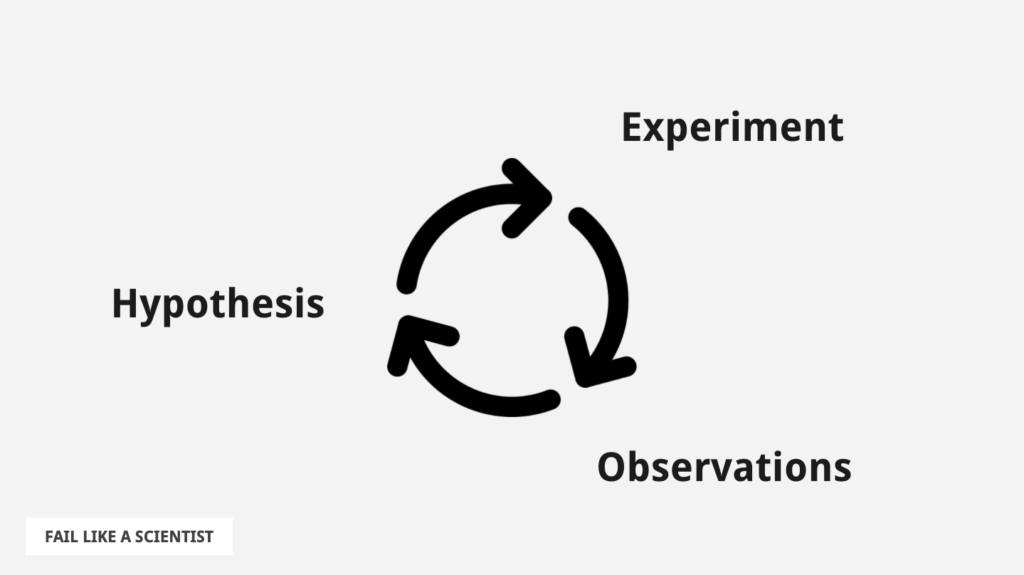Working on a new project, learning a new skill, trying a new experience—getting out of your comfort zone can be both exciting and frightening. Our fear of failure can be driven by many factors, including a fixed mindset or a fear of being judged. How can you overcome this fear? By learning to fail like a scientist.
“I have not failed 10,000 times. I have not failed once. I have succeeded in proving that those 10,000 ways will not work.”
Thomas Edison.
The scientific discovery process
The scientific method is considered one of the most rigorous ways of acquiring new knowledge. The scientific method involves formulating an hypothesis, performing an experiment, measuring the results, and refining the hypothesis based on the experimental findings.

Scientific experiments are not designed to succeed. They are designed to explore a question, and potentially increase knowledge of a problem. Scientists do not design their experiments to obtain a specific result—if they already knew what result they would get, there would be no point in performing the experiment.
For scientists, every result is a new data point. Regardless of the outcome of the experiment, the findings will feed the learning wheel by helping refine—and sometimes eliminate—the original hypothesis. How can we apply the scientific method principles to our own work and studies?
Learning as a perpetual experiment
To fail like a scientist is to embrace the experimental nature of life. Everything is an experiment, every failure a learning opportunity. It’s about having a growth mindset—where uncertainty is a positive sign that you are learning and growing.
Focus on progress over success. Success can be elusive and some of the most ambitious projects may take a long time to come to fruition. Your long-term success will largely depend on how you treat failure. Bury your head in the sand or call it quits without reflecting? Then failure will be failure. Consider failure as an addition to your personal knowledge bank, which helps you adjust your trajectory and get closer to success? Then each failure will be a step in the right direction.
Scientists, artists, and entrepreneurs have this mindset in common. Picasso produced an estimated 50,000 pieces of art. Thomas Edison famously said he failed 10,000 times before inventing the lightbulb. 26 out of 27 publishers rejected The Four Hour Workweek by Tim Ferris. Before she signed a deal, 36 publishers rejected Arianna Huffington’s book. Despite these initial failures, they all kept on going.
Failing like a scientist is also about continuously challenging your assumptions instead of blindly following a linear path to a specific goal. An outcome of the scientific method can be the complete elimination of a hypothesis. When you are learning, you may realise the goal you have been pursuing is no longer aligned with your overall objectives or principles. Instead of sticking to a goal just because, fail like a scientist and let it go.
Fail like a scientist to overcome your fear of failure
Learning to fail like a scientist is one of the most powerful mental models you can use to improve your productivity and your creativity. Here are some practical ways to implement the principles of the scientific method in your daily life and work:
- Replace imitation with exploration. Imitation feels safe. Many creatives and entrepreneurs stick to what they consider step-by-step playbooks from successful people. In some cases, it is possible to reproduce part of someone else’s success by applying a formula, but true breakthroughs never happen through pure imitation. Instead, take the road less traveled to explore new paths.
- Ask good questions. Avoid empty interrogations where the answer is already included in the question. Two of the most powerful questions you can ask yourself are “Why?” and “What if?” but sometimes, simply asking “How?” can lead to powerful new knowledge. Asking questions is an art which is great to practice both with other people—as part of a conversation—or on your own—as part of your self-reflection practice.
- Build a learning loop. Take inspiration from the scientific method to design your very own learning loop. Decide on an hypothesis, design an experiment, and learn from the feedback to improve your initial mental model.
- Celebrate progress over success. Instead of focusing on the finish line and our biggest achievement, take the time to celebrate your micro-wins—the small, daily victories and incremental accomplishments. Submitted an article to a publication? Don’t wait until you hear back from the editor to give yourself a pat on the back. Finally managed to fix a bug in your code? Make yourself a nice hot chocolate with extra cocoa on top. Learning is all about the journey, and the journey can be long—may as well make it enjoyable.
- Block time for reflection. Sometimes we get so busy with work, we forget to apply these scientific principles. Journaling is a great way to reflect on your progress. If you would like to use a more structured approach to self-reflection, the weekly review is also a great activity to incorporate in your mindful productivity routine.
Failing like a scientist is a learning process in itself. As with metalearning in general, it’s all about experimenting, making mistakes, and… Learning from them. While failing like a scientist is no guarantee to succeed, it will ensure you are at least going in the right direction.
